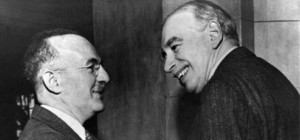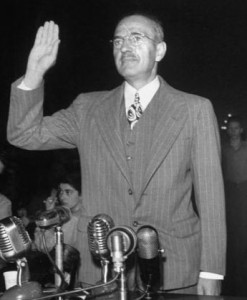White, Harry Dexter (1892-1948)
American Keynesian economist and U.S. Department of Treasury official; one of the founding fathers of the post-World War II economic system, known as the Bretton Woods system, who profoundly influenced the design and development of its major institutions, the International Monetary Fund (IMF) and the World Bank.
White was born in Boston, Massachusetts in October 1892 to a family of immigrants from Lithuania (then part of the Russian Empire.) He worked in the family hardware business and served during World War I as a First Lieutenant in the Infantry of the U. S. Army, spending some time overseas between April 1917 and February 1919. Following his return to the United States, White directed the American Expeditionary Force Orphan Asylum for two years. He received his B.A. in 1924 and his M.A. in 1925 from Stanford University, and his Ph.D. in 1930 from Harvard University. He then served as Professor of Economics at Laurence College in Appleton, Wisconsin. He was also an instructor in Economics at Harvard University.
In June 1934, White received an invitation from Professor Jacob Vinter of the University of Chicago to join him on an assignment at the U.S. Treasury Department in Washington, D.C. He was employed in the Office of the Secretary of the Treasury as an economic analyst from June to October 4, 1934. On November 1 of that year, he became a principal economic analyst in the Treasury Department’s Division of Research and Statistics. This was the beginning of his career at the Department, where he would eventually become an Assistant Secretary.
In the 1930s, White was an early advocate of restoring international monetary stability, which he saw as indispensable for the recovery of the American economy from the Great Depression. In 1935, he was sent to England to study economic and monetary questions. While there, he met with John Maynard Keynes, the father of Keynesian economics, and other prominent British economists, from whom, according to IMF historian James M. Boughton, he “gained a sense of the importance of Anglo-American cooperation in monetary affairs.” 1
In October 1936, White became assistant director of the U. S. Treasury Department’s Division of Research and Statistics, serving in that capacity until March 25, 1938, when he became director of the Division of Monetary Research. On August 5, 1941, he was appointed Assistant Secretary of the Treasury, in charge of the Division of Monetary Research. With the United States’s entry into World War II in December 1941, Treasury Secretary Henry Morgenthau put White in charge of all international matters for the Treasury Department.
White was also entrusted with the management of the U. S. Treasury’s $2 billion stabilization fund. He represented the Treasury on the Economic Defense Board, was a trustee of the Export-Import Bank in Washington, D.C. and was a member of the government’s Committee for Reciprocity Information, which was involved in reciprocal trade agreements with foreign countries. In 1943, White accompanied Secretary Morgenthau on a trip to Italy and North Africa.

Harry Dexter White with John Maynard Keynes
As the chief international economist at the U.S. Treasury, White drafted the U.S. blueprint for the International Monetary Fund, which competed with the plan drafted by Keynes for the British Treasury. During the United Nations Monetary and Financial Conference that took place from July 1 to July 22, 1944 at Bretton Woods, New Hampshire, he was the chief technical expert for the United States Government and delivered the daily press summary of the committee meetings. According to Boughton, “the final compromise on the IMF adopted at Bretton Woods retained much of the flavor of the White plan: it defined the IMF not as a world central bank but as a promoter of economic growth through international trade and financial stability.” 2
In September 1944, White was instrumental in drawing up the Morgenthau Plan for the treatment of Germany following World War II. He was also involved in developing Secretary Morgenthau’s postwar monetary proposals. 3
After the war, White was involved with setting up the institutions of the Bretton Woods system – the International Monetary Fund and the World Bank – which were designed to avoid the mistakes that had led to the Great Depression of the 1930s and to ensure the position of capitalism as the dominant post-war economic system. When the IMF began operating in 1946, President Harry S. Truman named White as its first U.S. Executive Director. White played a highly influential role during the IMF’s first year, before resigning in March 1947.
An important element in White’s post-war economic planning was his idea of international cooperation. As he wrote in 1942, “It would seem to be an important step in the direction of world stability if a member government could obtain the full cooperation of other member governments in the control of capital flows.” 4 White’s strong belief in the need for international cooperation to ensure global prosperity led him to take a strong position in favor of involving the Soviet Union in post-war economic institutions, particularly the IMF – despite the fact that the Soviet economic system was opposed to open trade and finance. Since 1942, White had taken a strong position in favor of engaging the Soviet Union, first in post-war economic planning, and then in the Bretton Woods institutions.
According to the late Professor Ray Mikesell, who became White’s adviser toward the end of World War II, and had been a member of the U.S. economists’ team at the Bretton Woods Conference, “White believed that the U.S. government should have sought closer cooperation with the Russians” – and “he was… quite willing to deal with Communist officials to achieve his objectives. The Soviet Union shared his political objectives regarding postwar Germany, and he believed that Soviet officials would support the Fund and the Bank proposals. He did not share the pervasive fear that the Communist ideology would spread to the rest of the world, or that the Soviet Union might dominate the world by military conquest. He believed that a Communist state could operate under a system of nondiscriminatory trade rules, abiding by the trade and exchange obligations of his plan.” Moreover, “through certain members of his staff, he provided information to and discussed policy with Soviet embassy officials.” 5
White’s plans were frustrated when the Soviet Union refused to join the IMF in late 1945. In a paper that he was writing before his death in August 1948, he lamented the “tensions between certain of the major powers” that had led to “almost catastrophic” consequences, including an “acute lack of confidence in continued political stability and the crippling fear of war on a scale unprecedented and almost unimaginable in its destructive potentialities.” 6
White’s activist engagement with the Soviets backfired in the mid-1940s after two defectors from the Communist cause, Whittaker Chambers and Elizabeth Bentley, independently accused him of providing information destined for Soviet intelligence. Beginning on November 8, 1945, the FBI sent a succession of reports to the White House and a number of government agencies naming White at the top of its list of individuals within government agencies suspected of espionage for the Soviet Union. 7
On July 31, 1948, Bentley said in her testimony to the House Committee on Un-American Activities that White had provided information for the Soviet Union during World War II. On August 3, 1948, Chambers testified before HUAC regarding his association with White in the 1930s. On August 13, 1948, White testified before HUAC to refute Bentley’s and Chambers’s accusations. Three days later, he died of a heart attack at the age of 55. On November 17, 1948, Chambers produced what became known as the Baltimore Documents – a batch of mostly typewritten summaries or verbatim copies of State Department documents which included five handwritten notes. One of these notes was identified as having been written by White in early 1938.
The release in 1995 and 1996 of Venona documentation – Soviet intelligence cables partially decrypted in the course of an American counterintelligence operation code-named Venona – has bolstered the early Cold War accusations against White, who was identified by Venona translators as a Soviet source code-named “Jurist” and “Richard.” In 1997, the bipartisan Commission on Government Secrecy, chaired by Democratic Senator Daniel Patrick Moynihan, stated in its findings that the complicity of Harry Dexter White seemed to be established. 8
Further evidence of White’s “complicity” emerged from exclusive access to KGB foreign intelligence archives provided in the early 1990s to a journalist and former KGB operative named Alexander Vassiliev, for a book undertaken as part of a joint Russian-American publishing project. (Later, after the original American publishers had withdrawn from the project, Vassiliev’s research would become the basis for a book named The Haunted Wood: Soviet Espionage in America – The Stalin Era (1999), which he co-authored with Allen Weinstein.
To see how these accusations stand when crosschecked against documentation from Russian archives:
Click here to read “Harry Dexter White in Alexander Vassiliev’s Notes” dossier
Click here to read an opinion if White had ever been a witting agent as he is commonly described
Watch for alerts on this website to see more fascinating documentation from Russian archives.
- James M. Boughton. “Harry Dexter White and the International Monetary Fund.” Finance and Development: A Quarterly Magazine of the IMF, September 1998, Vol. 35, No 3. ↩
- James M. Boughton. Op. cit. ↩
- Current Biography, September 1944, vol. 5, N 9, pp. 53-56. ↩
- Cit., James M. Boughton. Op. cit. ↩
- Ray Mikesell, Foreign Adventures of an Economist. Eugene: University of Oregon Press, 2000. – Cit., http://economistsview.typepad.com/economistsview/2006/09/an_insiders_vie.html ↩
- Cit., James M. Boughton. Op. cit. ↩
- Hoover to Vaughan, November 8, 1945, FBI Silvermaster File, No 65-56402, Vol. 16, Serials 376 to 420, PDF pp. 98-199; FBI memo: Harry Dexter White. – Ibid., Vol. 023, serials 561 to 573, February 21, 1946, PDF pp. 24-52; Underground Soviet Espionage Organization (NKVD) in Agencies of the United States Government, February 21, 1946. – in FBI Silvermaster File, Vol. 023, serials 561 to 573. ↩
- Report of the Commission on Protecting and Reducing Government Secrecy A-37. Appendix A: “SECRECY: A Brief Account of the American Experience.” United States Government Printing Office (1997). ↩


